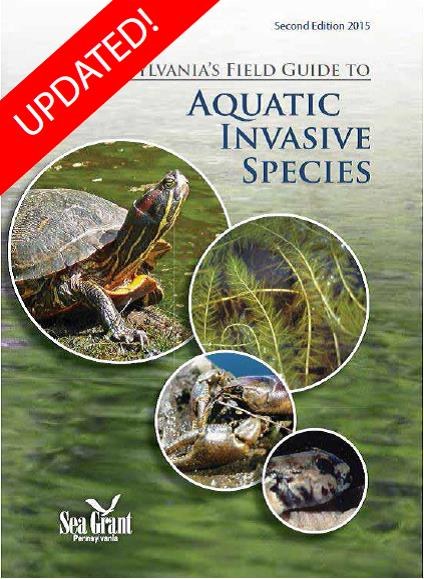Invasive species are not restricted to the land. Many invasive species that are problems in our water bodies are also part of our homes, as pets; in ponds or water gardens; or are moved via our recreational activities.

Pennsylvania's Field Guide to Aquatic Invasive Species is available through PA Sea Grant
Aquatic invasive species are spread primarily through human activities. Awareness and education among anglers, boaters and other water recreation participants as well as water garden and aquarium hobbyists are vital to limit their spread.
Here are some examples:
Aquatic Invasive Animals
Zebra mussels (Dreissena polymorpha) and
Quagga mussels (Dreissena rostriformis bugensis)
These fresh water mussels colonize hard surfaces. They are highly efficient filter feeders, removing phytoplankton from the water and starving other water animals. This disrupts the food web in aquatic systems. Human health risks arise from concentration of contaminants in the mussels that increase in fish feeding on the mussels and in anglers consuming the fish. Economic costs come from clogging intake pipes of water and power facilities as well as damage to boat propellers, hulls and fouling infrastructure like locks and dams.
Zebra Mussels
National Invasive Species Information Center
Quagga Mussels
National Invasive Species Information Center
Northern Snakehead (Channa argus)
These predators can potentially devastate native fish and wildlife populations. Young snakeheads eat zooplankton, insect and fish larvae and small crustaceans. Frogs, fish, crustaceans, small reptiles even small birds and mammals are taken by adults. Nicknamed "frankenfish," they tolerate poor water conditions and can move over land for short distances. They are well established in the Potomac River.
Snakeheads: The Newest Aquatic Invader
National Invasive Species Information Center
Aquatic Invasive Plants
Purple looseatrife (Lythrum salicaria)
Purple loosestrife fact sheet
Didymo or Rock Snot (Didymosphenia geminata)
Didymo, a freshwater alga, is primarily spread by anglers, boaters and their equipment but can also be spread on clothing of children or pets wading in an infested stream. It grows in stream beds on rocks creating clumps of stalk material up to 8 inches deep that carpet the bottom, disrupting the stream ecology.
National Invasive Species Information Center
Hydrilla (Hydrilla verticillata)Hydrilla is a federal noxious weed that grows quickly, forms dense mats and interferes with navigation, irrigation and can clog hydroelectric water intakes. The dense mats prevent sunlight penetration, shading desirable plants growing underneath. Blooms of this plant that later die in a pond can consume all the oxygen, causing a fish kill. It slows the flow of water in streams and irrigation ditches and can be found in freshwater lakes, ponds, rivers, canals and impoundments.
USDA invasive species info
PA DCNR Invasive Plant Search
European Water Chestnut (Trapa natans)
Dense floating mats choke waterways, limiting nutrients, light and oxygen for native organisms. It produces sharp nuts that can puncture shoes causing painful wounds and floating mats make boating and swimming nearly impossible.
National Invasive Species Information Center
VHS (Viral Hemorrhagic Septicemia)
Pennsylvania Department of Agriculture Aquaculture VHS CertificationFor information on aquatic invasive species and water gardens:
Aquatic Invasive Species & Water Gardens
For more information on aquatic invasive species:
Aquatic Nuisance Species (ANS) Task Force
Pennsylvania Fish & Boat Commission Aquatic Invasive Species
Pennsylvania Sea Grant Aquatic Invasive Species
Protect Your Waters
USGS Nonindigenous Aquatic Species (NAS) Site
Return to Pest Pages
Gypsy Moth
Gypsy moth is a cyclic insect that has been a problem in York county and will be again.
Invasive Tree Pests
Learn about Emerald Ash Borer, Asian Longhorned Beetle, and Thousand Canker Disease and other tree issues.
Invasive Plants
Many of the plants we see in our yards are not native to the mid-Atlantic region. Some of these plants are not good neighbors, and refuse to stay in our yards, with disastrous consequences.
Aquatic Invasive Species
Invasive species are not restricted to the land. Many invasive species that are problems in our water bodies are also part of our homes, as pets; in ponds or water gardens; or are moved via our recreational activities.
Native Alternatives
Consider the use of native plants in your yards and gardens instead of non-native plants. Here are resources to assist gardeners in making more eco-friendly selections.
Home and Garden Pests
Here are some unwelcome invasive guests common around the house or in your garden.

